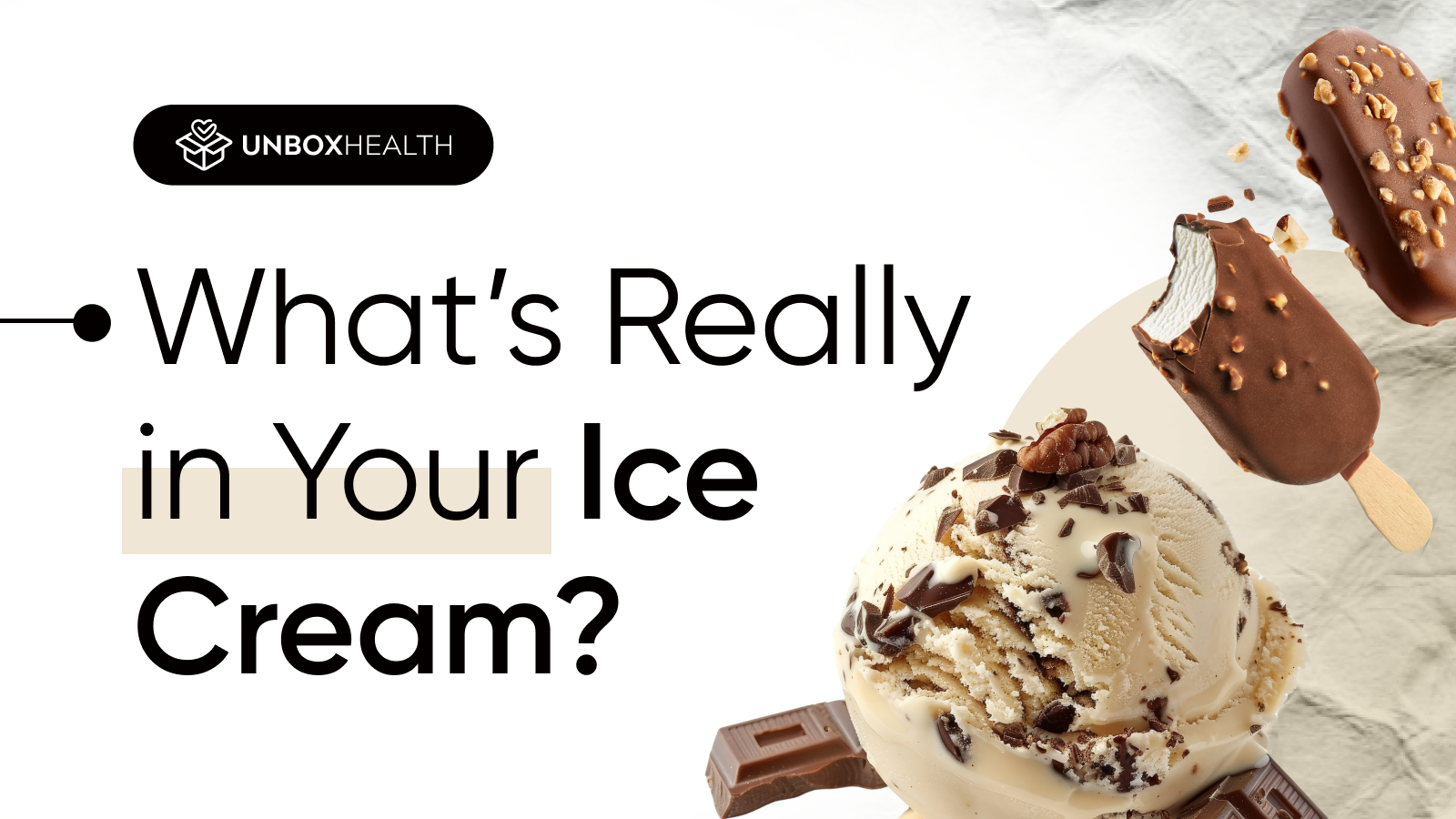Ice cream should be simple, just cream, milk, sweetness, and maybe a swirl of real fruit or nuts. But the reality is far more complicated. Most commercial ice creams sold in India today are loaded with thickeners, gums, emulsifiers, and other ultra-processed additives, all in the name of shelf life, texture, and cost-efficiency.
But at what cost to your health?
At Unbox Health, we sent India’s most popular ice creams to NABL-accredited labs and assessed their nutritional truth, label accuracy, and hidden toxicity.
Hidden Additives in Mainstream Ice Creams
Here are some of the most common “filler” ingredients in commercial ice creams and what science says about their health impact:
1. Guar Gum
A thickener made from guar beans. While technically plant-based, it ferments in the gut, leading to bloating, gas, and diarrhea in people with IBS or sensitive digestion [1].
2. Carrageenan
Extracted from red seaweed, carrageenan is widely used in dairy for its creamy texture. However, studies have linked it to intestinal inflammation, ulceration, and even colon cancer in animal models [2]. Even food-grade carrageenan is under increasing scrutiny.
3. Locust Bean Gum & Xanthan Gum
These stabilizers are used in combination for consistency and mouthfeel. But they may interfere with gut microbiota balance, especially when consumed frequently [3].
4. Mono- and Diglycerides
These emulsifiers help prevent ice cream from separating. However, they’re often derived from palm or soybean oil, and may contain hidden trans fats, which are linked to systemic inflammation and poor cardiovascular health [4].
5. Cellulose Gum / Cellulose Gel
Made from wood pulp. It adds volume cheaply and offers zero nutrition. Studies show that such ultra-processed additives are not recognized by the human gut and can disrupt digestive enzymes [5].
What Our Lab Tests Found
In July 2025, Unbox Health tested multiple best-selling ice creams available in the Indian market. Here’s what we uncovered:
- Nearly 90% had poor nutritional profile scores with excessive added sugar and low protein or fibre content.
- Label inaccuracies were common, especially for sugar and fat content.
- Traces of aflatoxin M1 and heavy metals like lead were detected in select samples within legal limits, but not without concern for long-term exposure.
How These Additives Affect Your Gut
Your gut isn’t just a digestive tube, it’s your body’s command center for immunity, mood, and metabolism. When you eat ultra-processed ingredients and synthetic additives:
- Good gut bacteria die off
- Bad microbes thrive, leading to dysbiosis
- Gut lining becomes permeable (aka leaky gut)You may experience:
- Bloating, gas, IBS-like symptoms
- Inflammation
- Lower immunity
- Fatigue and brain fog [6]
So, What Should You Look For Instead?
Next time you pick up a pint, flip it over and read the label. You’ll want to avoid:
- Carrageenan
- Guar gum
- Polysorbates
- Maltitol, sorbitol
- Mono- and diglycerides
- Nature-identical flavours
Instead, look for real, clean ingredients:
- Milk or nut milk
- Fresh cream
- Jaggery, dates, or honey (if sweetened)
- Real vanilla, cocoa, fruit, or nuts
- No preservatives or gums
Final Scoop
If you enjoy having ice cream frequently, especially children or those with digestive issues, it’s worth paying attention to what’s really inside the tub.
At Unbox Health, our aim is to empower you with lab-tested, science-backed insights, so that even your indulgences can be informed ones.
Check out unbiased lab-tested ratings of “Ice Creams” on Unbox Health along with their detailed lab reports.
About Unbox Health
Unbox Health: India’s First Ratings Platform for Packaged Foods and Health Supplement Tired of biased reviews and never-ending claims? At Unbox Health, every product is tested at multiple premium FSSAI-approved NABL-accredited international labs – 100% independently, transparently, and without any brand involvement.
- 100% Transparency: All lab reports are publicly published.
- Zero Hidden Agendas: Products are market-bought with no brand involvement.
- Accurate Testing: Samples tested at up to 3 premium international labs
- Actionable Ratings: Based on Label Accuracy, Toxicity & Nutritional Profile.
Head over to Unbox Health and let the data guide your consumption choices.
References:
- Slavin, J. L., & Green, H. (2007). Dietary fibre and satiety. Nutrition Bulletin, 32(S1), 32–42. https://doi.org/10.1111/j.1467-3010.2007.00610.x
- Weiner, M. L. (2016). Food additive carrageenan: Part II: A critical review of safety studies. Critical Reviews in Toxicology, 46(7), 635–662. https://doi.org/10.3109/10408444.2016.1140639
- Hamaker, B. R., & Tuncil, Y. E. (2014). A perspective on the complexity of dietary fiber structures and their potential effect on the gut microbiota. Journal of Molecular Biology, 426(23), 3838–3850. https://doi.org/10.1016/j.jmb.2014.07.028
- Mozaffarian, D., Katan, M. B., Ascherio, A., Stampfer, M. J., & Willett, W. C. (2006). Trans fatty acids and cardiovascular disease. New England Journal of Medicine, 354(15), 1601–1613. https://doi.org/10.1056/NEJMra054035
- Monteiro, C. A., Moubarac, J. C., Cannon, G., Ng, S. W., & Popkin, B. (2013). Ultra-processed products are becoming dominant in the global food system. Obesity Reviews, 14(S2), 21–28. https://doi.org/10.1111/obr.12107
- Chassaing, B., Koren, O., Goodrich, J. K., Poole, A. C., Srinivasan, S., Ley, R. E., & Gewirtz, A. T. (2015). Dietary emulsifiers impact the mouse gut microbiota promoting colitis and metabolic syndrome. Nature, 519(7541), 92–96. https://doi.org/10.1038/nature14232
